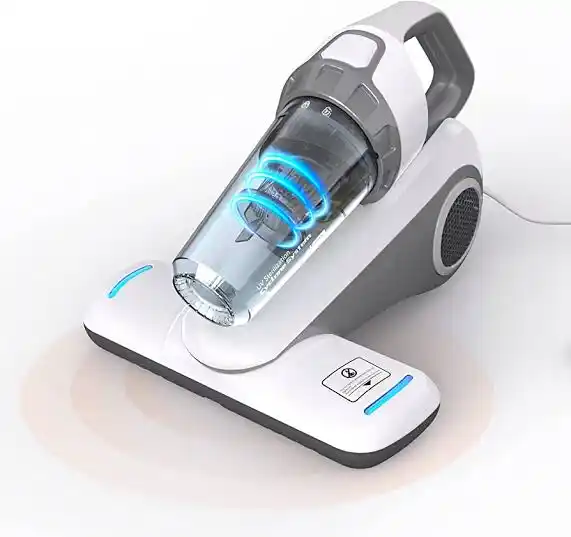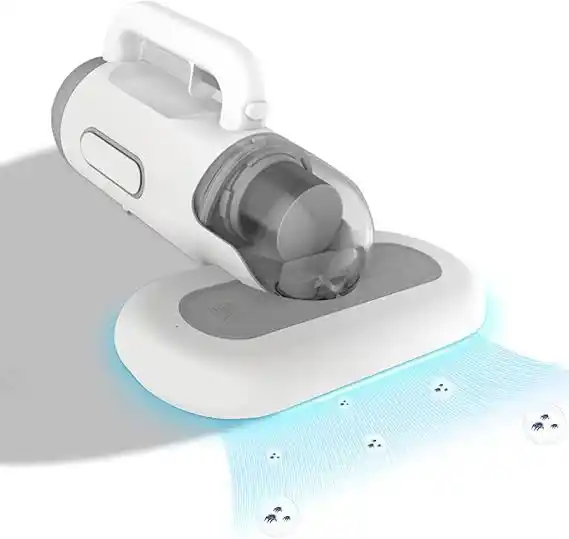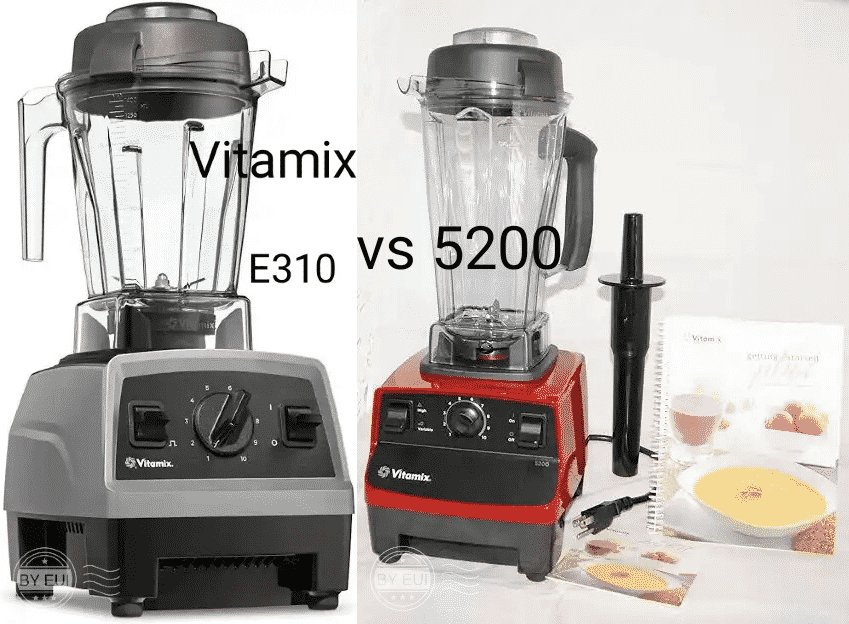In recent years, ultraviolet (UV) vacuums have emerged as a cutting-edge solution in the ongoing battle against household germs and allergens. Marketed with promises of eliminating up to 99.9% of bacteria, viruses, and dust mites, these high-tech devices have garnered significant attention from consumers seeking a cleaner, healthier home environment.
But do UV vacuums truly deliver on their impressive claims, or are they another fleeting trend in the vast landscape of home cleaning gadgets? This article delves into the science behind UV technology, evaluates the effectiveness of UV vacuums in practical settings, and provides insights from both experts and users to determine if these devices are worth the investment.
UV Vacuum Cleaners
A UV vacuum is a type of cleaning device that combines traditional vacuuming with ultraviolet (UV) light technology to enhance its cleaning capabilities. Unlike standard vacuums that rely solely on suction to remove dirt, dust, and debris, UV vacuums are equipped with UV-C light, a specific wavelength of ultraviolet light known for its germicidal properties. This UV-C light is designed to kill or deactivate microorganisms such as bacteria, viruses, and dust mites on surfaces as the vacuum passes over them.
The concept behind UV vacuums is to provide a more thorough cleaning by not only removing visible dirt but also sanitizing surfaces to reduce the presence of harmful pathogens and allergens. This dual-action approach aims to improve indoor air quality and promote a healthier living environment, making UV vacuums particularly appealing to households with allergy sufferers, pet owners, or individuals concerned about hygiene and cleanliness.
How UV Vacuum Cleaners Work
UV vacuums operate through a combination of traditional vacuuming and ultraviolet (UV-C) light technology. Here’s how they work:
- Vacuuming Mechanism:
- Suction: Like traditional vacuums, UV vacuums use powerful suction to lift dirt, dust, and debris from surfaces such as carpets, upholstery, and hard floors. This is typically achieved through a motorized fan that creates a low-pressure area inside the vacuum, drawing in air and particles.
- Filtration: The captured particles pass through a filtration system, often including HEPA (High-Efficiency Particulate Air) filters, which trap small particles and allergens, preventing them from being released back into the air.
- UV-C Light Technology:
- UV-C Light Emission: UV vacuums are equipped with UV-C lamps that emit ultraviolet light at a wavelength of 253.7 nanometers. UV-C light has germicidal properties, capable of breaking down the DNA and RNA of microorganisms, rendering them inactive or killing them.
- Surface Disinfection: As the vacuum moves across surfaces, the UV-C light irradiates the area directly in front of the vacuum’s intake nozzle. This exposure to UV-C light can effectively reduce the presence of bacteria, viruses, dust mites, and other pathogens on surfaces.
- Duration and Proximity: For effective disinfection, the UV-C light needs to be in close proximity to the surface and applied for a sufficient duration. Most UV vacuums are designed to optimize this by ensuring the light is directed at a narrow area and maintained for the necessary time as the vacuum is moved slowly over surfaces.
- Safety Features:
- Automatic Shut-off: Many UV vacuums have built-in safety features such as automatic shut-off mechanisms that turn off the UV-C light when the vacuum is lifted off the surface, preventing accidental exposure to the user.
- Enclosed Light Source: The UV-C light is often enclosed within the vacuum body to minimize the risk of direct exposure to eyes and skin, ensuring safe operation while cleaning.
By integrating these two technologies, UV vacuums aim to provide a deeper clean that not only removes physical debris but also sanitizes surfaces, making them a popular choice for those looking to enhance hygiene in their homes.
Claims by Manufacturers
Manufacturers of UV vacuums make several claims regarding the benefits and effectiveness of their products. These claims often focus on the advanced cleaning capabilities and health benefits provided by the combination of vacuuming and UV-C light technology. Here are some common claims made by manufacturers:
- Germ and Bacteria Elimination:
- UV vacuums are said to eliminate up to 99.9% of germs, bacteria, and viruses on surfaces, contributing to a more hygienic home environment.
- The UV-C light is claimed to effectively deactivate the DNA of microorganisms, preventing them from replicating and causing illness.
- Allergen Reduction:
- Manufacturers assert that UV vacuums can significantly reduce allergens such as dust mites, pet dander, and pollen, which can help alleviate symptoms for allergy sufferers.
- The combined action of suction and UV-C light is promoted as an effective method to remove and neutralize allergens from various surfaces.
- Improved Indoor Air Quality:
- By capturing fine particles and killing airborne pathogens, UV vacuums are said to improve indoor air quality, making the home environment healthier and safer.
- HEPA filters and other advanced filtration systems are often highlighted as key features that trap allergens and pollutants, preventing them from being recirculated into the air.
- Enhanced Cleaning Efficiency:
- The addition of UV-C light is promoted as a way to enhance the overall cleaning efficiency of the vacuum, providing a deeper clean compared to traditional vacuums.
- UV vacuums are often marketed as being particularly effective on mattresses, upholstery, and other soft surfaces where dust mites and bacteria thrive.
- Ease of Use and Convenience:
- Manufacturers claim that UV vacuums are easy to use, with ergonomic designs and user-friendly features such as automatic UV light shut-off for safety.
- Many UV vacuums are cordless or lightweight, making them convenient for everyday use around the home.
- Odor Elimination:
- Some UV vacuums are said to help eliminate odors caused by bacteria and mold, leaving the home smelling fresher.
- Pet-Friendly Benefits:
- For pet owners, UV vacuums are marketed as effective tools for removing pet hair and dander, as well as for reducing odors associated with pets.
These claims are designed to appeal to consumers looking for advanced cleaning solutions that go beyond the capabilities of traditional vacuums, promising not only cleaner surfaces but also improved health and comfort at home.
Studies and Research
Research and studies on the effectiveness of UV vacuums have provided mixed results, with some studies supporting the claims of manufacturers and others highlighting limitations. Here’s an overview of key findings from various studies:
- Efficacy of UV-C Light:
- General Effectiveness: Multiple studies have confirmed that UV-C light is effective in inactivating a broad spectrum of microorganisms, including bacteria, viruses, and fungi. For example, research published in the American Journal of Infection Control demonstrated that UV-C light could reduce microbial contamination on hospital surfaces by over 99% under controlled conditions.
- Specific to Household Use: The effectiveness of UV-C light in household settings varies. Studies have shown that UV-C light can reduce dust mite populations on mattresses and soft furnishings, though the degree of reduction depends on factors like exposure time and proximity to the surface.
- Combined Vacuum and UV-C Technology:
- Integrated Devices: A study published in the Journal of Occupational and Environmental Hygiene examined a UV-C emitting vacuum cleaner and found that it significantly reduced dust mite allergen levels on carpeted surfaces. However, the reduction was not significantly greater than that achieved by vacuuming alone, suggesting that the UV-C light provided an additional but not substantially superior benefit.
- Practical Limitations: Research indicates that for UV-C light to be highly effective, it must be in close proximity to the surface and for a sufficient duration, which can be challenging to maintain consistently during regular vacuuming.
- User Experiences and Real-World Applications:
- Consumer Reports: Some consumer-focused evaluations, such as those by Consumer Reports, have found that while UV vacuums can offer additional cleaning benefits, the overall improvement in cleanliness and allergen reduction may be marginal compared to high-quality conventional vacuums.
- User Reviews: Anecdotal evidence from user reviews often highlights satisfaction with the perceived cleanliness and reduced allergen levels after using UV vacuums, though these reports are subjective and vary widely.
- Health Impact:
- Allergy Relief: Studies on the health benefits of UV vacuums for allergy sufferers show mixed results. While some users report fewer allergy symptoms, clinical studies provide limited data on the direct correlation between UV vacuum use and improved health outcomes.
- Safety Concerns: UV-C light exposure can be harmful to skin and eyes. Studies emphasize the importance of safety features, such as automatic shut-off mechanisms, to prevent accidental exposure.
- Comparative Studies:
- Standard vs. UV Vacuums: Comparative studies often reveal that while UV vacuums can be more effective at reducing microbial loads on surfaces, the overall difference in effectiveness compared to high-performance traditional vacuums may not justify the higher cost for all users.
Effectiveness on Common Allergens

The effectiveness of UV vacuums on common allergens such as dust mites, pet dander, pollen, and mold spores varies, but there is evidence to suggest that they can provide some benefits. Here’s a detailed look at how UV vacuums perform against these allergens:
- Dust Mites:
- Mechanism: UV-C light can kill or deactivate dust mites by damaging their DNA. UV vacuums also physically remove dust mite debris and feces through suction.
- Effectiveness: Studies have shown that UV-C light can reduce dust mite populations on surfaces like mattresses and upholstery. For instance, research published in the Journal of Allergy and Clinical Immunology indicated that UV-C light significantly reduced dust mite allergens on treated surfaces. However, the effectiveness depends on the duration and intensity of UV exposure.
- Pet Dander:
- Mechanism: UV vacuums remove pet hair and dander (skin flakes) through suction and may reduce associated bacteria and allergens with UV-C light.
- Effectiveness: While UV-C light can kill bacteria on pet dander, its impact on the allergenic proteins in dander is less clear. The primary benefit comes from the vacuum’s ability to remove dander from surfaces, which can reduce overall allergen levels in the home.
- Pollen:
- Mechanism: Pollen particles can be effectively removed from surfaces by the suction power of the vacuum. UV-C light may help by killing any microbial contaminants on the pollen.
- Effectiveness: UV vacuums can help reduce pollen particles on floors, carpets, and upholstery. However, the UV-C light’s effect on pollen itself is minimal since pollen allergens are not living organisms and thus not affected by UV-C light in the same way bacteria or dust mites are.
- Mold Spores:
- Mechanism: UV-C light can kill or deactivate mold spores by disrupting their DNA. The vacuum’s suction removes spores from surfaces.
- Effectiveness: Studies, such as those reported in the Applied and Environmental Microbiology journal, have shown that UV-C light can effectively reduce mold spore viability. However, achieving significant results requires proper exposure time and proximity. UV vacuums can be beneficial in areas prone to mold growth by both removing spores and reducing their ability to reproduce.
Limitations and Practical Considerations:
- Exposure Time: The UV-C light must be in close contact with the surface for a sufficient amount of time to be effective. Rapid movement or insufficient exposure can reduce the germicidal efficacy.
- Surface Penetration: UV-C light does not penetrate deeply into fabrics or thick materials. Therefore, its effectiveness is primarily limited to surface layers.
- Safety: Proper safety features, such as automatic shut-off when the vacuum is lifted, are crucial to prevent harmful UV exposure to humans and pets.
Limitations of UV Vacuum Cleaners
While UV vacuum cleaners can be effective at removing some harmful particles from your home, they do have limitations. For one, UV vacuum cleaners are not effective at removing larger particles like dirt and debris.
Additionally, UV vacuum cleaners are often more expensive than traditional vacuum cleaners and may require additional maintenance. But due to how expensive vacuums can be to purchase, not everyone can afford it. So it’s best to make use of alternative options.
Alternative Cleaning Methods
If you’re not sold on the effectiveness of UV vacuum cleaners or are looking for alternative cleaning methods, there are a few options to consider.
One option is steam cleaning, which uses high heat to kill bacteria and other microorganisms. Another option is to use air purifiers, which can remove harmful particles from the air in your home.
Consumer Reviews of UV Vacuum Cleaners
Consumer reviews of UV vacuum cleaners are mixed. While some report that their UV vacuum cleaner has helped alleviate their allergies and improve the air quality in their home, others report little to no effect.
Additionally, some users have reported issues with the durability and maintenance of their UV vacuum cleaners.
Factors to Consider Before Purchasing a UV Vacuum Cleaner

Before purchasing a UV vacuum cleaner, there are a few factors to consider. First, think about your specific cleaning needs and whether a UV vacuum cleaner is the best solution for you.
Additionally, consider the cost and maintenance requirements of a UV vacuum cleaner compared to a traditional vacuum cleaner.
Conclusion:
While UV vacuums can enhance the removal and neutralization of common allergens, their effectiveness is maximized when used correctly, with attention to exposure time and surface coverage. They can be particularly useful in households with allergy sufferers, providing an added layer of protection against allergens that traditional vacuums might miss. However, they should be seen as a complement to, rather than a replacement for, comprehensive cleaning and allergen management strategies.


![10 Best Ninja Blenders [updated 2023] - Top 5 Picks & Reviews 5 best ninja blenders](https://www.reviewmast.com/wp-content/uploads/2021/03/best-ninja-blenders.jpeg)
![7 Best Quiet Blenders [2023 updates]: Reviews & Top Picks 6 best quiet blenders](https://www.reviewmast.com/wp-content/uploads/2022/03/best-quiet-blenders-to-buy.webp)